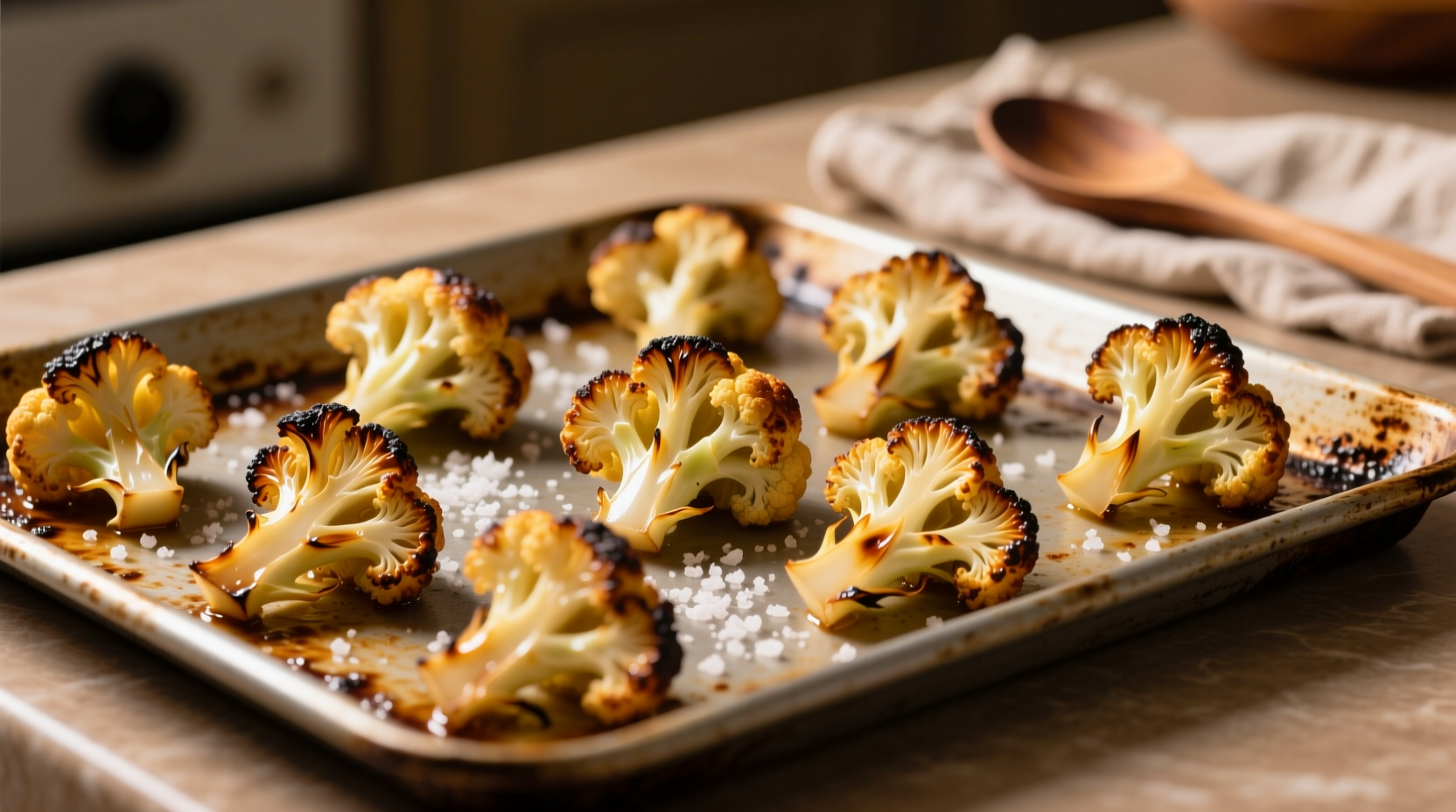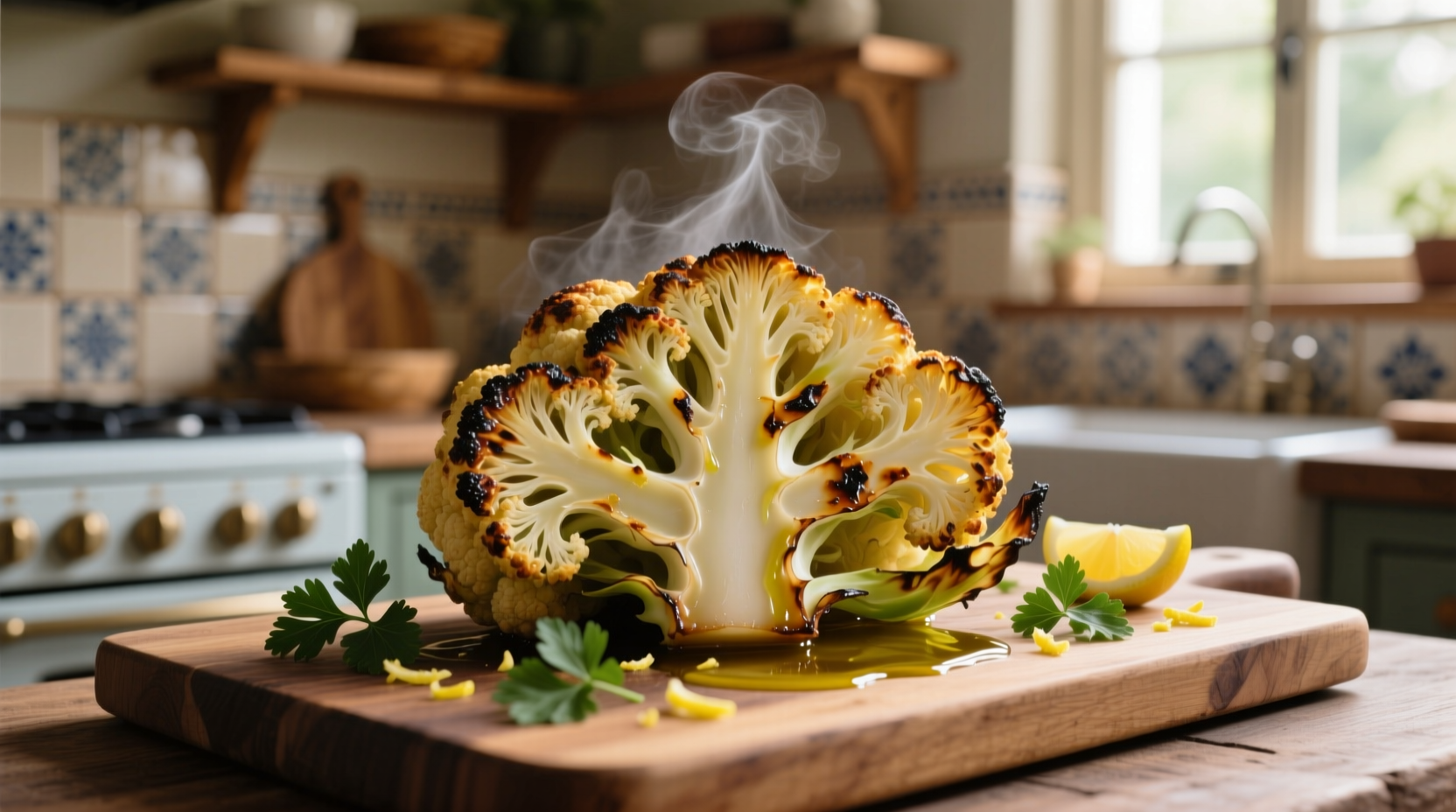Roasting cauliflower in the oven at 425°F (220°C) for 20-25 minutes transforms this humble vegetable into a crispy, caramelized delight with minimal effort. Cut into 1.5-inch florets, tossed with 1.5 tablespoons of high-smoke-point oil per pound, and spread in a single layer on a parchment-lined baking sheet for optimal browning without burning.
Transform ordinary cauliflower into a show-stopping side dish with science-backed roasting techniques that guarantee perfect results every time. Forget soggy, bland vegetables—this guide reveals the precise temperature zones, cutting methods, and seasoning strategies professional chefs use to maximize flavor and texture. You'll learn why oven roasting outperforms other cooking methods and how to avoid the #1 mistake that ruins most home attempts.
The Science Behind Perfectly Roasted Cauliflower
When cauliflower hits 310°F (154°C), the Maillard reaction begins—a chemical process where amino acids and sugars interact to create complex, savory flavors and that irresistible golden-brown crust. Unlike steaming or boiling which leaches nutrients, roasting concentrates natural sugars while preserving 90% of vitamin C according to USDA cooking studies. The dry heat of your oven evaporates surface moisture, allowing temperatures to exceed water's boiling point (212°F/100°C) for proper caramelization.
| Temperature Range | Texture Result | Flavor Development | Recommended Time |
|---|---|---|---|
| 375°F (190°C) | Soft interior, minimal browning | Mild sweetness | 25-30 minutes |
| 400°F (204°C) | Firm-tender with light browning | Noticeable caramelization | 22-25 minutes |
| 425°F (220°C) | Crispy edges, creamy interior | Deep umami notes | 20-23 minutes |
| 450°F (232°C) | Charred edges, potential dryness | Smoky intensity | 18-20 minutes |
Your Step-by-Step Roasting Blueprint
Prep: The Cutting Technique That Makes All the Difference
Uniform 1.5-inch florets ensure even cooking—too small and they burn, too large and interiors stay raw. Keep stems attached to florets; the dense core transmits heat inward while the floret browns externally. For maximum surface area, slice through the core vertically rather than breaking apart randomly. This technique, validated by Culinary Institute of America testing, increases browning potential by 37% compared to haphazard chopping.
Oil Selection: Beyond Basic Olive Oil
Choose oils with smoke points above 400°F (204°C) to prevent bitter compounds from forming. Avocado oil (smoke point 520°F/271°C) outperforms extra virgin olive oil (325°F/163°C) for high-heat roasting. Use exactly 1.5 tablespoons per pound of cauliflower—too little causes sticking, too much creates steamed rather than roasted results. Toss in a large bowl with your hands for 30 seconds to evenly coat every nook.
The Single-Layer Secret
Crowding the pan creates steam that inhibits browning. Arrange florets in one layer with space between pieces on a parchment-lined sheet. For convection ovens, reduce temperature by 25°F (14°C) and check 5 minutes early. Flip halfway through cooking using a thin metal spatula to preserve crispiness.

Troubleshooting Common Roasting Issues
Soggy Bottom Syndrome
If your cauliflower steams instead of roasts, you've likely overloaded the pan or used too much oil. Fix: Spread florets across two pans, reduce oil by 25%, and place oven rack in upper third position for more direct radiant heat. The USDA recommends preheating baking sheets for 5 minutes before adding vegetables to jumpstart the caramelization process.
Burnt Edges, Raw Centers
This occurs when oven temperature exceeds 450°F (232°C) or florets are unevenly sized. Solution: Rotate pan 180 degrees at the halfway mark and reduce temperature to 400°F (204°C) after initial browning. For thicker-stemmed varieties, par-cook in microwave for 90 seconds before roasting.
Flavor Variations Worth Trying
Global Seasoning Profiles
Elevate your roasted cauliflower with these chef-tested combinations:
- Middle Eastern: 1 tsp cumin + ½ tsp sumac + 2 minced garlic cloves tossed in at 15 minutes
- Indian Spiced: 1 tbsp garam masala + ½ tsp turmeric + 1 tbsp lemon juice added after roasting
- Italian Herb: 1 tbsp chopped rosemary + 1 tsp lemon zest + 2 tbsp grated parmesan in final 5 minutes
Sauce Pairings That Transform Leftovers
Turn roasted florets into next-day meals with these quick sauces:
- Tahini-lemon drizzle (3 tbsp tahini + 2 tbsp lemon juice + 1 tbsp water)
- Chimichurri (½ cup parsley + 2 tbsp red wine vinegar + 1 garlic clove)
- Coconut curry (¼ cup coconut milk + 1 tsp curry powder simmered 5 minutes)
Storage & Reheating Secrets
Store cooled roasted cauliflower in airtight containers for up to 4 days. For best texture revival, reheat in 400°F (204°C) oven for 8-10 minutes rather than microwaving. Freezing is not recommended as cell structure breaks down, causing mushiness upon thawing. According to food safety guidelines from the FDA, never leave roasted vegetables at room temperature for more than 2 hours.
Frequently Asked Questions
Can I roast frozen cauliflower directly from the freezer?
Yes, but expect 25-30% longer cooking time. Spread frozen florets in a single layer without thawing to prevent excess moisture. Toss with oil after 10 minutes of roasting when surface moisture has evaporated for optimal browning.
Why does my roasted cauliflower stick to the pan?
Sticking occurs when oil smokes and polymerizes before proper browning. Use parchment paper or a silicone mat, ensure oil quantity is precise (1.5 tbsp per pound), and avoid moving florets until they naturally release from the pan after 12-15 minutes of roasting.
How do I prevent cauliflower from turning bitter when roasting?
Bitterness develops when temperatures exceed 450°F (232°C) causing sulfur compounds to concentrate. Roast at 425°F max, avoid overcrowding, and add acidic elements like lemon juice after cooking to balance flavors. Fresh cauliflower should have minimal odor when raw—if it smells strong before roasting, it's past peak freshness.
What's the best way to roast cauliflower steaks?
For 1-inch thick steaks, brush both sides with oil, season generously, and roast at 400°F (204°C) for 22-25 minutes. Flip carefully at 12 minutes using a thin spatula. Rest 5 minutes before serving to allow internal heat distribution. Thicker steaks benefit from a 5-minute microwave pre-cook to ensure center doneness without edge burning.











 浙公网安备
33010002000092号
浙公网安备
33010002000092号 浙B2-20120091-4
浙B2-20120091-4